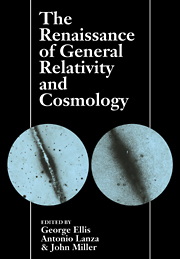 The Renaissance of General Relativity and Cosmology
The Renaissance of General Relativity and Cosmology Published online by Cambridge University Press: 15 December 2009
Galaxies are the building blocks of the Universe, and most of what we know about them has been discovered since Dennis Sciama became a research student. In the space available to me it is not possible to cover even in outline all significant developments during this period. So I have tried to concentrate on what seem to me to be the most important themes. My choice must surely be heavily influenced by personal taste and experience; I hope only that my prejudices are not too glaringly evident.
THE STRUCTURE OF THE MILKY WAY
Galactic astronomy in the 1950s was dominated by the discovery (Ewen & Purcell, 1951) of the 21 cm line predicted by H. C. van der Hulst in 1944. This made it possible for the first time to study the large-scale kinematics of the Milky Way. For the most part the 21 cm observations confirmed the picture of a disk in differential rotation developed by Oort more than twenty years before. However, there were surprises — most notably the discovery that the disk is warped rather than being perfectly flat (Burke, 1957; Kerr, 1957).
Extinction of stars by dust had first betrayed the existence of the interstellar medium (Trumpler 1930).
To save this book to your Kindle, first ensure [email protected] is added to your Approved Personal Document E-mail List under your Personal Document Settings on the Manage Your Content and Devices page of your Amazon account. Then enter the ‘name’ part of your Kindle email address below. Find out more about saving to your Kindle.
Note you can select to save to either the @free.kindle.com or @kindle.com variations. ‘@free.kindle.com’ emails are free but can only be saved to your device when it is connected to wi-fi. ‘@kindle.com’ emails can be delivered even when you are not connected to wi-fi, but note that service fees apply.
Find out more about the Kindle Personal Document Service.
To save content items to your account, please confirm that you agree to abide by our usage policies. If this is the first time you use this feature, you will be asked to authorise Cambridge Core to connect with your account. Find out more about saving content to Dropbox.
To save content items to your account, please confirm that you agree to abide by our usage policies. If this is the first time you use this feature, you will be asked to authorise Cambridge Core to connect with your account. Find out more about saving content to Google Drive.